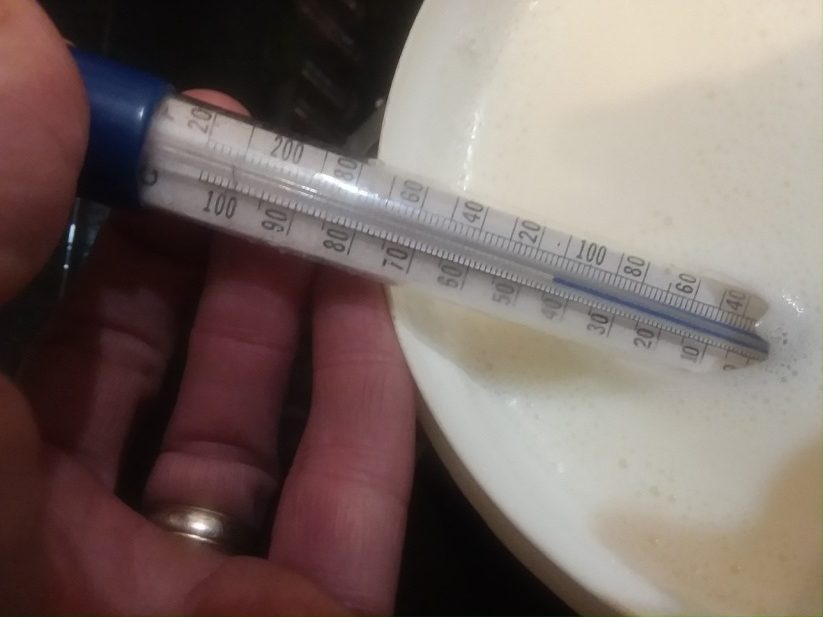Like beer and wine, the origins of yogurt are unknown. But it is believed to have been invented in Mesopotamia around 5000 BC. Ogurt has been widely used throughout the world. The process was industrialized in 1919 when a started a small yogurt business began in Barcelona, Spain, and named the business Danone , later known in the United States as Dannon. Yogurt with added fruit jam was patented in 1933.
At the Homebrew Emporium we are all about food and fermentation. Yogurt is one of those foods that we really love. It’s easy to make, taking maybe 15 or 20 minutes to heat the milk to 185° and then cool it to 110° and add the yogurt culture.
We’ve used the Yogotherm for years. This equipment makes ½ gallon of yogurt overnight.


The Yogotherm is something like a big thermos bottle. It consists of a ½ gallon plastic pail with a lid. That fits inside a Styrofoam canister with another insulated lid. This keeps the temperature constant while the yogurt’s bacterial culture does its fermentation. Fermentation of lactose by these bacteria produces lactic acid. This acts on milk protein to give yogurt its texture and characteristic tart flavor. Cow’s milk the milk most commonly used to make yogurt. Milk used may be homogenized or not with substantially different results.
Yogurt is made using a lactobacillus delbruecki subspecies bulgaricus and Streptococcus thermophilus bacteria. Other lactobacilli and bifidobacteria are also sometimes added.

Get started by going to your favorite store and getting a ½ gallon of whole milk. Skim milk can be used, but the consistency will be thinner. Pour it in a pot and turn the heat on. A thermometer is needed to monitor the temperature. Keep stirring so the bottom of the pot isn’t scorched. Once the temperature reaches 185° turn the heat off. Heating the milk to 185° denatures the milk’s proteins so they are not able to form curds.

Pour the hot milk into the plastic pail and immerse in cold water in the sink.



Cool the milk to 110°. There are a number of culturess available. Some give a drier yogurt, some sweeter.


Cut the culture package open and sprinkle it on to the milk. Below you can see the yogurt culture floating on the milk.

Now the waiting begins. The temperature must be maintained for four to twelve hours to allow fermentation. I usually make this in the evening and it’s ready in the morning. Longer fermentation produces a more acid yogurt.
Milk with a higher concentration of solids may be used producing a firmer yogurt. One way solids can be increased by adding dried milk. Yogurt functions as a probiotic and offers a variety of health benefits that go well beyond those of plain milk as long as live cultures are present. Yogurt is also a rich source of calcium and protein, and may reduce the risk of osteoporosis.

In the morning the yogurt is opened.


If you put the yogurt in smaller containers it can be saved for a week or so.
Plain yogurt from whole milk is 81% water, 9% protein, 5% fat, and 4%carbohydrates, including 4% sugars. A 100-gram serving provides 97 kcal. Yogurt is a rich source of vitamin B12 and riboflavin.
Although regular yogurt is very healthy, large amounts of sugar, or other sweeteners, are often used in commercial yogurt. Some yogurts contain added modified starch, pectin (found naturally in fruit), and/or gelatin to create thickness and creaminess artificially at lower cost.
Strained yogurt is becoming more popular with those who make yogurt at home. Yogurt strained through a filter, traditionally made of muslin, removes the whey, giving a much thicker consistency. This gives it higher protein content, although there is also lower calcium content.
You can make your own yogurt using the Yogotherm. They are available at our stores for only $59.95. Stop by the grocery store on the way home for a half gallon of milk and you can eat your own home made yogurt for breakfast tomorrow. Throw in some fruit or nuts and enjoy life.
